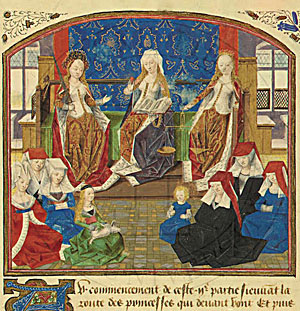F is for Fashion
 |
| Hildegard of Bingen |
Let’s start with some basic terms:
Tunic: the main garment of the habit, worn by both monks and nuns. (In fact, worn by most everyone in the Middle Ages.)
Scapular: a long, rectangular piece of fabric that hung from the shoulders.
Cowl: sort of a small cape worn over the shoulders. Again, typical to dress in the Middle Ages.
Hood: for monks (and most men).
Veil: for nuns (and most women). Often worn with a wimple, a piece of cloth that would cover the neck and chin. During most of the Middle Ages, it was considered improper for any woman, whether a nun or a wife, to show her hair, so the head covering was crucial.
Rosary: worn at the belt by some orders.
Different orders were distinguished by the differences in their habits. For example, many medieval stories (such as The Canterbury Tales) refer to brown friars (the Franciscans), white friars (the Dominicans), and black friars (the Benedictines): the three most widespread orders at the time.
Some orders were discalced--or barefoot--thus distinguished by the fact that as a penance they didn’t wear shoes. Many monks and nuns sported a hairshirt, made from scratchy goats’ hair, beneath their tunics, or rough ropes about their waists.
Nuns’ veils varied in style, corresponding mostly to the time at which the order was founded, as they tended to reflect the styles worn by simple women of the age. Thus some were very simple, like this:
While others were rather more ornate:
The medieval nun, mystic, writer, composer, scientist (and all-around Super Woman) Hildegard of Bingen (see image at top) encouraged the nuns in her order to wear beautiful habits of silk, as befitted brides of Christ. But most orders were known for embracing poverty and simplicity in their dress.
In fact, as you can see, the dress of monastic orders wasn’t so unique at the time it originated. What’s pretty cool, though, is that most of these habits can still be seen on monks and nuns today. They’ve preserved a little bit of history--the dress of the medieval commoner--for us to see today. Even if it’s sometimes through the bars of a cloister.


Fashion is such an interesting topic! It influences all people and groups. Thanks for sharing! Hope you have a great weekend, Faith. :)
ReplyDeleteFaith, (Your name happens to be my word for today.) An informative post. I love the illumination/illustration at the top!
ReplyDeleteThere's an order of holy adoration nuns (whose work is to pray continually) here in Philly whose habits are a delightful bright pink. Their order dates from the 1890s. Their fashion seems medieval with a Victorian twist.
ReplyDelete